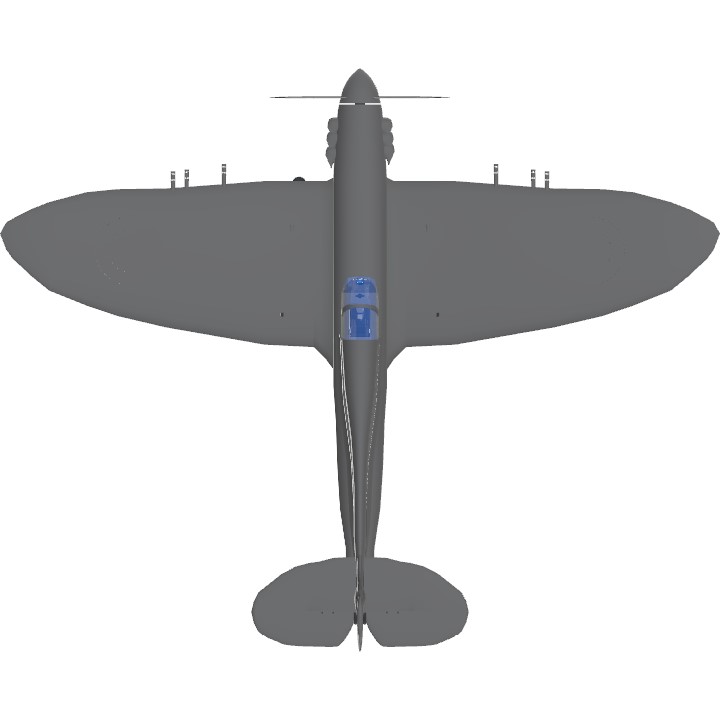controls: VTOL down: Flaps
wiki info:
The Supermarine Spitfire is a British single-seat fighter aircraft used by the Royal Air Force and other Allied countries before, during, and after World War II. Many variants of the Spitfire were built, from the Mk 1 to the Rolls-Royce Griffon-engined Mk 24 using several wing configurations and guns. It was the only British fighter produced continuously throughout the war. The Spitfire remains popular among enthusiasts; around 70 remain airworthy, and many more are static exhibits in aviation museums throughout the world.
The Spitfire was designed as a short-range, high-performance interceptor aircraft by R. J. Mitchell, chief designer at Supermarine Aviation Works, which operated as a subsidiary of Vickers-Armstrong from 1928. Mitchell developed the Spitfire's distinctive elliptical wing (designed by Beverley Shenstone) with innovative sunken rivets to have the thinnest possible cross-section, achieving a potential top speed greater than that of several contemporary fighter aircraft, including the Hawker Hurricane. Mitchell continued to refine the design until his death in 1937, whereupon his colleague Joseph Smith took over as chief designer, overseeing the Spitfire's development through many variants.
During the Battle of Britain (July–October 1940), the public perceived the Spitfire to be the main RAF fighter; however, the more numerous Hurricane shouldered more of the burden of resisting the Luftwaffe. Nevertheless, the Spitfire was a better fighter aircraft than the Hurricane. Spitfire units had a lower attrition rate and a higher victory-to-loss ratio than those flying Hurricanes, probably because of the Spitfire's higher performance. During the battle, Spitfires generally engaged Luftwaffe fighters—mainly Messerschmitt Bf 109E–series aircraft, which were a close match for them.
Specifications
Spotlights
- blt 1.5 years ago
- Bryan5 1.5 years ago
- PlayMinecraft 1.4 years ago
- whwh2011 1.5 years ago
- DmytroNehustorov228 1.5 years ago
General Characteristics
- Created On Windows
- Wingspan 48.0ft (14.6m)
- Length 38.9ft (11.9m)
- Height 13.8ft (4.2m)
- Empty Weight 22,278lbs (10,105kg)
- Loaded Weight 48,143lbs (21,837kg)
Performance
- Horse Power/Weight Ratio 0.041
- Wing Loading 10.2lbs/ft2 (50.0kg/m2)
- Wing Area 4,698.1ft2 (436.5m2)
- Drag Points 7987
Parts
- Number of Parts 252
- Control Surfaces 7
- Performance Cost 1,025







⣿⣿⣿⣿⡿⠟⠛⠛⠛⠛⠉⠉⠙⠛⠛⠿⢿⣿⣿⣿⣿⣿⣿⣿⣿⡿⠿⠟⠀⠀
⣿⣿⣯⣥⣤⣶⣶⣶⣶⣿⣿⣿⣿⣿⣿⣷⣾⣿⣿⣿⣿⣿⣿⣿⣏⣀⣀⣀⡀⠀
⣿⣿⣿⣿⣿⣿⣿⡿⠿⠛⠛⠻⠿⠟⠉⠉⠉⢻⣿⣿⣿⡿⠟⠋⣡⣼⣿⣿⣿⡄
⣿⣿⣿⣟⣭⣤⣶⣶⣿⣿⠃⠀⠀⢀⣀⣤⣶⣿⣿⣿⣿⡅⡀⢀⣩⣤⣤⠀⠀⠀
⣿⣿⣿⣿⣿⣿⣛⡛⠛⠛⠛⢋⣩⣿⣿⣿⣿⣿⣿⣿⣿⣿⣿⣛⠛⠛⠓⠠⠀⠀
⣿⣿⣿⣿⣿⣿⣿⣿⣿⣿⣿⣿⣿⣿⣿⣿⣿⣿⣿⣿⣿⣿⣿⣿⣦⣤⣤⣤⣦⠀
⣿⣿⣿⣿⣿⣿⣿⣿⣿⣿⣿⣿⣿⣿⣿⣿⣿⣿⣿⣿⣿⣿⣿⣿⣿⣿⣿⣿⣿⡇
⣿⣿⣿⣿⣿⣿⣿⣿⣿⣿⣿⣿⣿⣿⣿⣿⣿⣿⠿⠿⠿⠿⠿⢿⡿⢿⣿⣿⣿⠃
⠿⠿⠿⠿⢿⣿⣿⣿⣿⣿⣿⣿⣿⣿⣿⣥⣄⣀⣀⠀⠀⠀⠀⠀⢰⣾⣿⣿⠏⠀
⠀⠀⠀⠀⠀⠀⠉⣩⣿⣿⣿⣿⣿⣿⣿⣿⣿⣿⣿⣿⣿⣿⣶⣤⣜⡻⠋⠀⠀⠀
⣰⣾⣷⣶⣿⣾⣖⣻⣿⣿⡿⣿⣿⣿⣿⠿⠿⠟⠛⠛⠛⠋⠉⠉⢉⡽⠃⠀⠀⠀
⣿⣿⣿⣿⣿⣿⡉⠉⠉⠛⠛⠛⠉⠁⠀⠀⠀⠀⠀⠀⠀⠀⡤⠚⠉⠀⠀⠀⠀⠀
⠛⠛⣿⣿⣿⣿⣿⣿⣿⠉⠛⢶⣶⣄⠀⠀⠀⠀⠀⠀⠀⠀⡇⠀⠀⠀⠀⠀⠀⠀
⠠⣾⣿⣿⣿⣿⣿⠿⠟⠃⠀⠀⠀⠈⠲⣴⣦⣤⣤⣤⣶⡾⠁⠀⠀⠀⠀⠀⠀⠀
⠄⠈⠉⠻⢿⣿⣿⡀⠀⠀⠀⠀⠀⠀⠀⠀⠉⠛⠛⠛⠉⠀⠀⠀⠀⠀⠀⠀⠀⠀
This is Sick!!
Great work